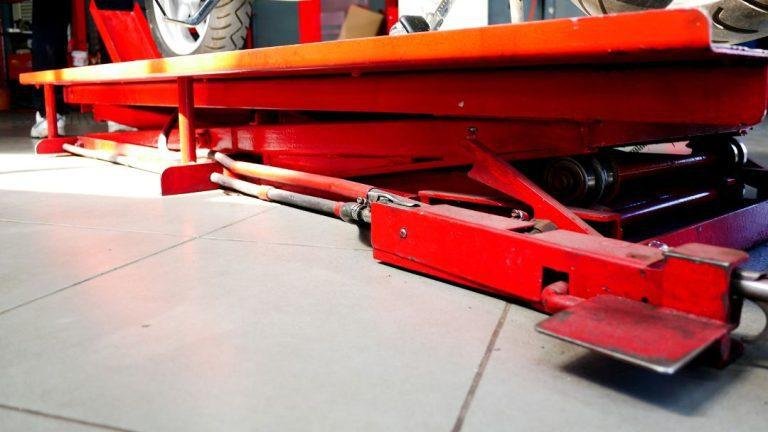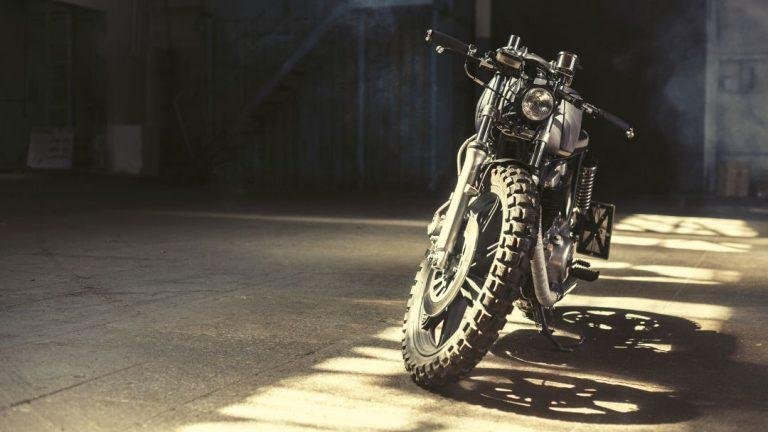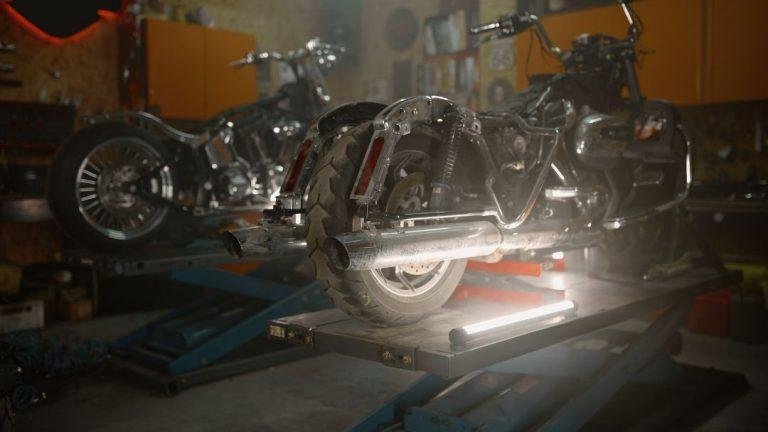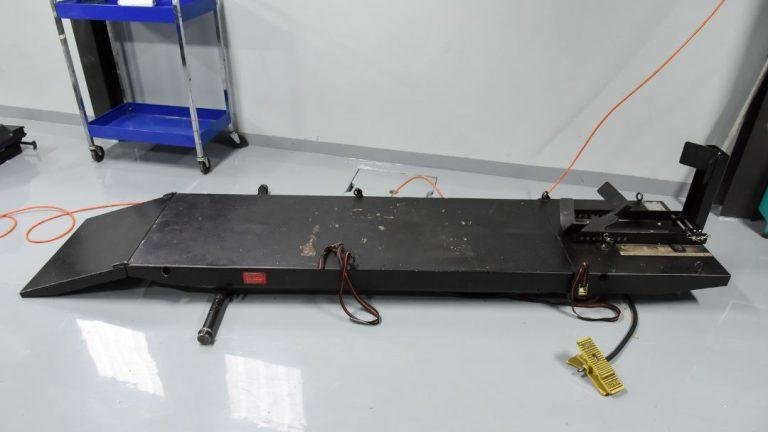To lift a motorcycle on a car lift, position the lift arms under the motorcycle frame, ensure the bike is balanced, and slowly raise it using the lift’s controls. Additionally, ensure that the lift is securely locked before working on the motorcycle.
When it comes to lifting a motorcycle onto a car lift, there are a few simple steps that you can follow. By positioning the lift arms under the motorcycle frame and ensuring the bike is balanced, you can safely raise it using the lift’s controls.
It’s important to make sure that the lift is securely locked before working on the motorcycle to prevent any accidents or injuries. We will explore the step-by-step process of lifting a motorcycle on a car lift, providing you with the necessary information to do so effectively and safely. Read on to learn more about this useful skill.
Choosing The Right Car Lift For Your Motorcycle
Choosing the perfect car lift for your motorcycle is essential to ensure safety and convenience. Lift your motorcycle effortlessly by following our guide on how to utilize a car lift specifically designed for motorcycles.
When it comes to lifting a motorcycle on a car lift, choosing the right lift is essential for a safe and successful lift. Consider the following factors to ensure you select the appropriate car lift for your motorcycle:
Consider the weight capacity of the car lift:
- Check the weight capacity of the car lift to ensure it can safely support the weight of your motorcycle.
- Verify the maximum weight rating of the lift and compare it to the weight of your bike, including accessories and additional equipment.
- Opt for a car lift with a weight capacity that exceeds the weight of your motorcycle to ensure stability and prevent damage.
Ensure the lift has the appropriate width and length for your motorcycle:
- Measure the width and length of your motorcycle to determine the dimensions required for the car lift.
- Look for a lift with a platform that accommodates the width and length of your bike, allowing for a secure fit.
- A lift that is too narrow or too short may pose safety risks and make it challenging to position the motorcycle properly.
Look for adjustable arms or supports to accommodate different bike types:
- Verify if the car lift has adjustable arms or supports that can accommodate different types of motorcycles.
- Adjustable arms or supports allow you to customize the positioning of your bike, ensuring stability and ease of use.
- This feature is particularly crucial if you own multiple motorcycles or plan on lifting different bike models in the future.
Selecting the right car lift for your motorcycle is vital to ensure a safe and hassle-free lifting experience. Consider the weight capacity, dimensions, and adjustability features to find a lift that meets the specific needs of your bike. By choosing the appropriate car lift, you can lift your motorcycle with confidence and peace of mind.
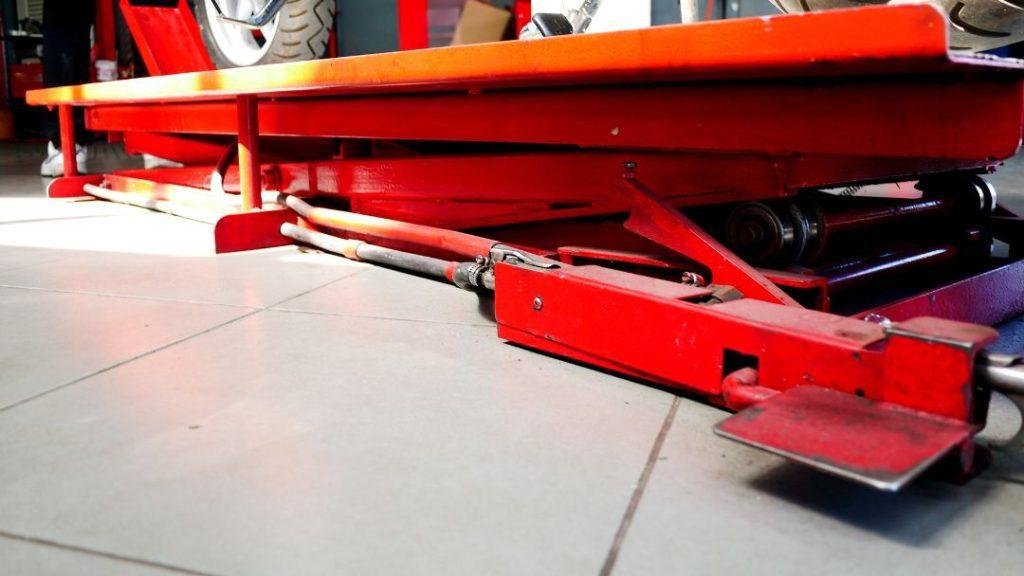
Preparing Your Motorcycle For Lifting
Ensure your motorcycle is well-prepared for lifting on a car lift by following these steps, including securing loose parts, emptying fuel tanks, and removing any added accessories. Safely elevate your motorcycle for maintenance or storage with these helpful tips.
Before you lift your motorcycle onto a car lift, it’s important to ensure that it’s properly prepared. This will help prevent any accidents or damage during the lifting process. Follow these steps to prepare your motorcycle for lifting:
Remove Any Loose Items Or Accessories From The Bike:
- Prior to lifting your motorcycle, remove any loose items or accessories that may be attached to it. This includes saddlebags, windshields, or any other removable items. Removing these items will not only make the lifting process safer but also protect these accessories from any potential damage.
Ensure The Motorcycle Is In Neutral Gear:
- It is crucial to make sure that your motorcycle is in neutral gear before lifting it. This ensures that the wheels won’t turn during the lifting process, making it safer and easier to position the bike on the car lift.
Turn Off The Engine And Remove The Key:
- Before lifting your motorcycle, always turn off the engine and remove the key from the ignition. This is a safety measure that helps prevent any unexpected movement or accidental starts while the bike is being lifted.
Securely Fasten The Straps Or Restraints To Prevent Movement During Lifting:
- To ensure the stability and safety of your motorcycle during lifting, securely fasten straps or restraints to prevent any movement. This will help keep the bike in place and prevent it from slipping or tipping over. Make sure the straps are tightened adequately but not too tight to avoid causing any damage to the motorcycle.
By following these steps to prepare your motorcycle for lifting, you can ensure a smooth and safe experience when using a car lift. Proper preparation is key to protecting both your bike and yourself during the lifting process.
Lifting Your Motorcycle Safely On A Car Lift
Learn the proper way to lift your motorcycle safely on a car lift with these simple steps. Ensure a secure and efficient process for motorcycle maintenance or storage.
Lifting a motorcycle onto a car lift may seem like a daunting task, but with a few simple steps, you can do it safely and efficiently. Follow these instructions to ensure a smooth and secure lifting process:
Position The Car Lift’S Arms Or Supports Under The Bike Frame:
- Position the motorcycle in a central location on the car lift.
- Check that the lift’s arms or supports are aligned with the bike’s frame.
- Place the arms or supports under the frame, making sure they are securely positioned.
Slowly Raise The Lift Until The Motorcycle Is Just Above The Ground:
- Engage the lift mechanism and begin raising the platform slowly.
- Monitor the lift’s progress, ensuring that the bike is lifted gradually to prevent sudden movements.
- Stop lifting when the bike is just above the ground, ensuring it is neither too high nor too low.
Check For Stability And Adjust The Supports If Necessary:
- Inspect the motorcycle for any signs of instability or imbalance.
- If needed, adjust the arms or supports to ensure proper balance and stability.
- Double-check that the bike is securely positioned before continuing the lifting process.
Continue Raising The Lift Until The Bike Is At The Desired Height For Maintenance Or Storage:
- Gradually raise the car lift while continuously monitoring the bike’s stability.
- Stop once the motorcycle reaches the desired height for maintenance or storage.
- Ensure that the lift is completely raised and locked in place before beginning any work.
Remember, safety is paramount when lifting a motorcycle on a car lift. Take your time, follow the instructions diligently, and always prioritize stability and balance. Following these steps will help you lift your motorcycle safely onto a car lift, allowing for easy access and maintenance.
Securing The Motorcycle On The Car Lift
To safely lift a motorcycle on a car lift, use sturdy straps and secure them tightly around the bike’s frame and handlebars. Make sure the motorcycle is stable and balanced before raising it up on the lift.
When it comes to lifting a motorcycle on a car lift, it is crucial to ensure it is securely held in place. Utilizing additional straps or restraints can provide that extra level of security. Here are some key points to keep in mind when securing your motorcycle on the car lift:
- Use high-quality straps: Invest in strong and durable straps specifically designed for motorcycles. These will offer higher safety standards and better grip.
- Anchor points: Find appropriate anchor points on the motorcycle to attach the straps. Look for sturdy areas such as the frame or handlebars to ensure a secure connection.
- Double-check strap tightness: Before lifting the motorcycle, double-check that all straps are tight and secure. Tightening the straps will prevent any unnecessary movement during maintenance or repairs.
- Strap positioning: Make sure the straps are positioned correctly to distribute the load evenly. This will help maintain balance and stability while the motorcycle is lifted.
- Secure the front and rear: Attach straps to both the front and rear of the motorcycle. This balanced approach will help ensure stability throughout the lifting process.
- Cross-strap technique: Consider using a cross-strap technique for added security. Crisscross the straps at the front and rear of the motorcycle to provide a more stable grip.
- Use additional restraints if necessary: If you feel the need for added security, consider using additional restraints such as ratchet straps or bungee cords. These can provide an extra layer of support during the lifting process.
- Inspect all straps: Regularly inspect and maintain your straps to ensure they remain in good condition. Look for signs of wear and tear, fraying, or weak spots. Replace any damaged straps immediately.
- Balance and stability: Before performing any work on the motorcycle, ensure it is well-balanced and stable on the car lift. This will minimize the risk of accidents or movement during the maintenance process.
- Perform a final check: Once the motorcycle is secured on the car lift, perform a final check of all the straps and restraints. Ensure they are properly tightened and in good condition before proceeding with any work.
By following these steps, you can safely secure your motorcycle on a car lift, providing you with peace of mind and stability while performing maintenance or repairs.
Lowering The Motorcycle From The Car Lift
Lowering a motorcycle from a car lift is a simple process. Carefully secure the bike, engage the reverse gear, slowly release the lift’s mechanism, and lower the bike gently onto the ground. Double-check for stability before removing the straps and enjoying your ride.
Gradually Lower The Lift Until The Bike Is Safely On The Ground:
- Lowering the motorcycle from the car lift requires careful execution to ensure a smooth and safe landing. Here’s how to do it step by step:
- Begin the process by slowly lowering the car lift, ensuring each movement is controlled and deliberate.
- Keep a close eye on the motorcycle as it descends, paying attention to any potential issues or obstacles that may arise.
- Use the lift’s controls to adjust the height accordingly, maintaining a steady downward motion until the bike is safely on the ground.
- Take your time throughout this process, as rushing could lead to accidents or damage to the motorcycle.
- Stay alert and focused on the bike’s position to prevent any sudden shifts or instability during the descent.
- Once the motorcycle is low enough, release the controls and allow it to settle securely on the ground.
- Confirm that the bike is fully supported and stable before moving on to the next step.
Remove All Straps And Restraints Before Attempting To Ride The Motorcycle:
- Before you even think about hopping on your motorcycle after lowering it from a car lift, it’s vital to remove any straps or restraints that were used during the lifting process. Here’s why:
- Straps and restraints may restrict the bike’s movement and pose a safety hazard if not properly removed.
- Carefully inspect the motorcycle to identify any straps, harnesses, or other fastenings that may need to be released.
- Loosen and remove all straps one by one, ensuring that no part of the motorcycle is still attached or restricted in any way.
- Double-check to make sure you haven’t missed any restraints, as any oversight could lead to accidents or damage later on.
- Once all the straps are removed, take a moment to confirm that the motorcycle is free from any encumbrances or potential hindrances to its functionality and safety.
Conduct A Final Inspection To Make Sure The Bike Is In Proper Condition:
- After lowering the motorcycle from a car lift and removing all straps and restraints, it’s crucial to conduct a thorough final inspection. Here are the steps to help you ensure the bike is in proper condition:
- Examine the motorcycle’s overall appearance, paying attention to any visible damage or signs of wear and tear that may have occurred during the lifting process.
- Check the tires for proper inflation and any indications of punctures or wear.
- Inspect the suspension, brakes, and other crucial components to ensure they are functioning correctly and haven’t been affected by the lifting procedure.
- Test the lights, turn signals, and horns to ensure they are operational.
- Verify that the bike’s fluids, such as oil and coolant, are at optimal levels.
- Look for any loose or missing bolts, nuts, or other fasteners that may need tightening or replacement.
- Take the time to adjust the mirrors and other personal preferences to ensure optimum visibility and comfort.
- Only once you are satisfied with the bike’s condition should you consider getting on and riding it. Remember, safety should always be the top priority.
Remember, a proper lift and lowering process, along with a comprehensive inspection, are essential for the overall safety and performance of your motorcycle. Take your time, follow the steps diligently, and enjoy your ride with peace of mind!
Safety Precautions And Expert Tips For Lifting Motorcycles On Car Lifts
Discover essential safety precautions and expert tips for safely lifting motorcycles on car lifts. Learn the proper techniques to ensure a secure and smooth lifting process, increasing efficiency and reducing potential risks.
Lifting a motorcycle on a car lift requires caution and adherence to safety precautions. By following these expert tips, you can ensure a safe and efficient lifting process:
Wear Appropriate Personal Protective Equipment (Ppe)
To protect yourself from any potential accidents or injuries, it is crucial to wear the right personal protective equipment. Consider the following ppe:
- Safety goggles: Shield your eyes from debris or dust particles
- Gloves: Provide a better grip and protect your hands from sharp edges
- Sturdy work boots: Ensure stability and protect your feet from falling objects
Make Sure The Car Lift Is On A Stable And Level Surface
Before lifting the motorcycle, it is vital to ensure the car lift is on a stable and level surface. This prevents any unnecessary movement and keeps the lifting process safe and secure. Take the following steps:
- Check the ground: Ensure the floor surface is stable and not prone to shifting or sinking.
- Verify stability: Make sure the car lift is fully engaged and securely positioned on the ground, without any wobbling or tilting.
- Use leveling devices: If needed, employ leveling devices such as shims or blocks to ensure the lift is completely level.
Have A Second Person Assist In The Lifting Process If Possible
Lifting a motorcycle on a car lift can be cumbersome and potentially dangerous if attempted alone. Having an extra pair of hands can make the process safer and more efficient. Here’s why a second person is invaluable:
- Distribute weight: With a second person, you can evenly distribute the weight of the motorcycle, reducing the strain on both the lift and yourself.
- Assist with stability: The additional person can help stabilize the motorcycle during the lifting process to prevent it from tipping or falling.
- Provide guidance: Working as a team allows for clear communication and guidance, ensuring a smoother lifting experience.
Avoid Overloading The Lift Beyond Its Weight Capacity
Exceeding the weight capacity of a car lift is extremely dangerous and can lead to catastrophic accidents. Always exercise caution and adhere to the manufacturer’s weight limits. Follow these guidelines:
- Check weight capacity: Before attempting to lift the motorcycle, verify that it falls within the weight capacity specified by the car lift manufacturer.
- Distribute weight evenly: Ensure that the weight of the motorcycle is evenly distributed on the lift platform to avoid placing excessive strain on any specific points.
- Consider modifications: If you frequently need to lift heavier motorcycles, it may be wise to invest in a car lift with a higher weight capacity.
With these essential safety precautions and expert tips in mind, you can confidently lift motorcycles on car lifts while minimizing risks and ensuring a smooth and secure lifting experience.
Frequently Asked Questions For How To Lift A Motorcycle On A Car Lift
Can You Put A Motorcycle On A Car Lift?
Yes, you can absolutely put a motorcycle on a car lift. Car lifts are designed to lift and hold heavy vehicles for maintenance or storage purposes. They usually have a weight capacity that is sufficient to handle the weight of a motorcycle as well.
By placing the motorcycle securely on the lift platform, you can easily raise and lower it just like you would with a car. This allows for easier access to the underside of the motorcycle for maintenance or repairs. Make sure to position the motorcycle properly on the lift to ensure stability and balance.
Additionally, it is important to use straps or clamps to secure the motorcycle to the lift to prevent any accidental movement or tipping. By following these precautions, you can safely and efficiently use a car lift for your motorcycle.
How Do You Lift A Motorcycle With A Lift?
To lift a motorcycle with a lift, follow these steps: 1. Position the lift: ensure the lift is on a stable and level surface. 2. Secure the motorcycle: place the motorcycle on the lift platform and engage the safety mechanism. 3.
Pump the lift: use the hydraulic pump to raise the lift platform, gradually lifting the motorcycle off the ground. 4. Check stability: once the motorcycle is lifted, check its stability and make any necessary adjustments. 5. Perform maintenance: now that the motorcycle is lifted, you can work on maintenance tasks, such as changing the oil or servicing the tires.
6. Lower the lift: when you’re done, slowly and safely lower the lift platform, ensuring the motorcycle is stable before removing it. Remember, always follow the lift manufacturer’s instructions and take necessary safety precautions when lifting a motorcycle.
How Do You Secure A Motorcycle On A Lift?
To secure a motorcycle on a lift, follow these steps: 1. Position the lift in a stable area with enough space to maneuver. 2. Place the motorcycle in neutral gear and switch off the engine. 3. Attach straps or tie-downs to secure the handlebars, frame, and rear tire.
4. Tighten the straps to secure the motorcycle firmly in place. 5. Double-check that all straps are secure before raising the lift. 6. Slowly raise the lift, ensuring it lifts evenly and the motorcycle remains stable. 7. Once the desired height is reached, set the lift’s safety lock in place.
8. Inspect the lift and straps periodically during maintenance or storage. 9. When ready to remove the motorcycle, lower the lift gradually and remove the straps. Remember to follow the lift manufacturer’s instructions and consult your motorcycle’s manual for any specific considerations.
How Do You Lift A Heavy Motorcycle By Yourself?
To lift a heavy motorcycle by yourself, follow these steps: 1. Position yourself near the bike, facing it directly. 2. Bend your knees and use your leg muscles to squat down. 3. Place one hand on the handlebar and the other hand under the rear seat or frame.
4. Slowly stand up, using your legs to lift the motorcycle off the ground. 5. Be mindful of your back and lift with your legs to avoid injury. 6. Once the motorcycle is off the ground, walk it with small steps to move it where needed.
7. To lower the bike, reverse the process by squatting down and using your leg muscles to lower it gently back to the ground.
Conclusion
Lifting a motorcycle on a car lift may seem like a daunting task, but with the right knowledge and tools, it can be done safely and efficiently. By following the step-by-step instructions outlined in this blog post, you’ll be able to confidently lift your motorcycle onto a car lift without any hassle.
Remember to ensure that the car lift you are using is capable of supporting the weight of your motorcycle, and always use the necessary safety precautions, such as securely strapping down the bike and wearing protective gear. Whether you’re a motorcycle enthusiast or a professional mechanic, knowing how to lift a motorcycle on a car lift is a valuable skill that can save you time and effort in the long run.
So, go ahead and give it a try – you’ll be amazed at how easy it can be to lift your motorcycle on a car lift!


